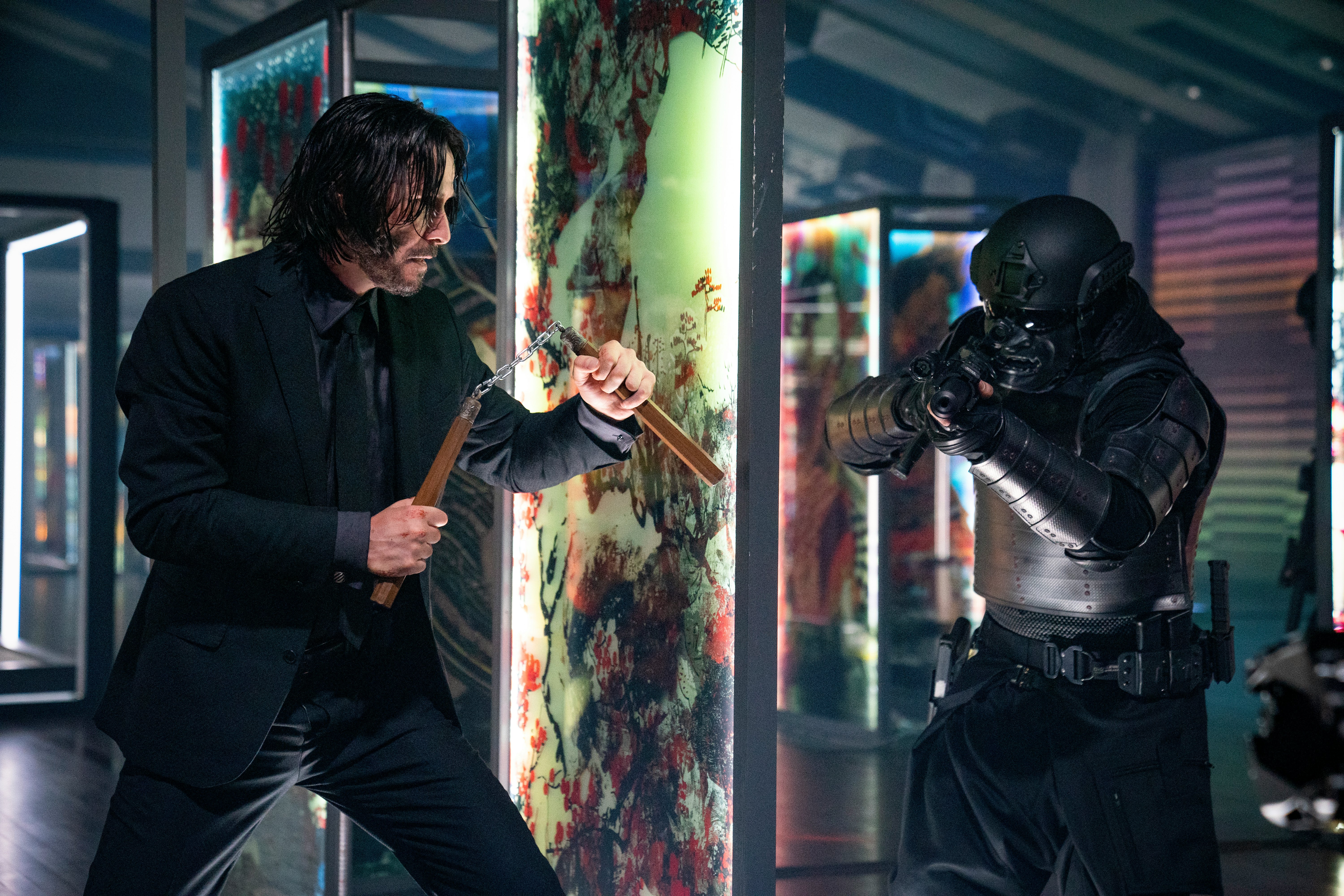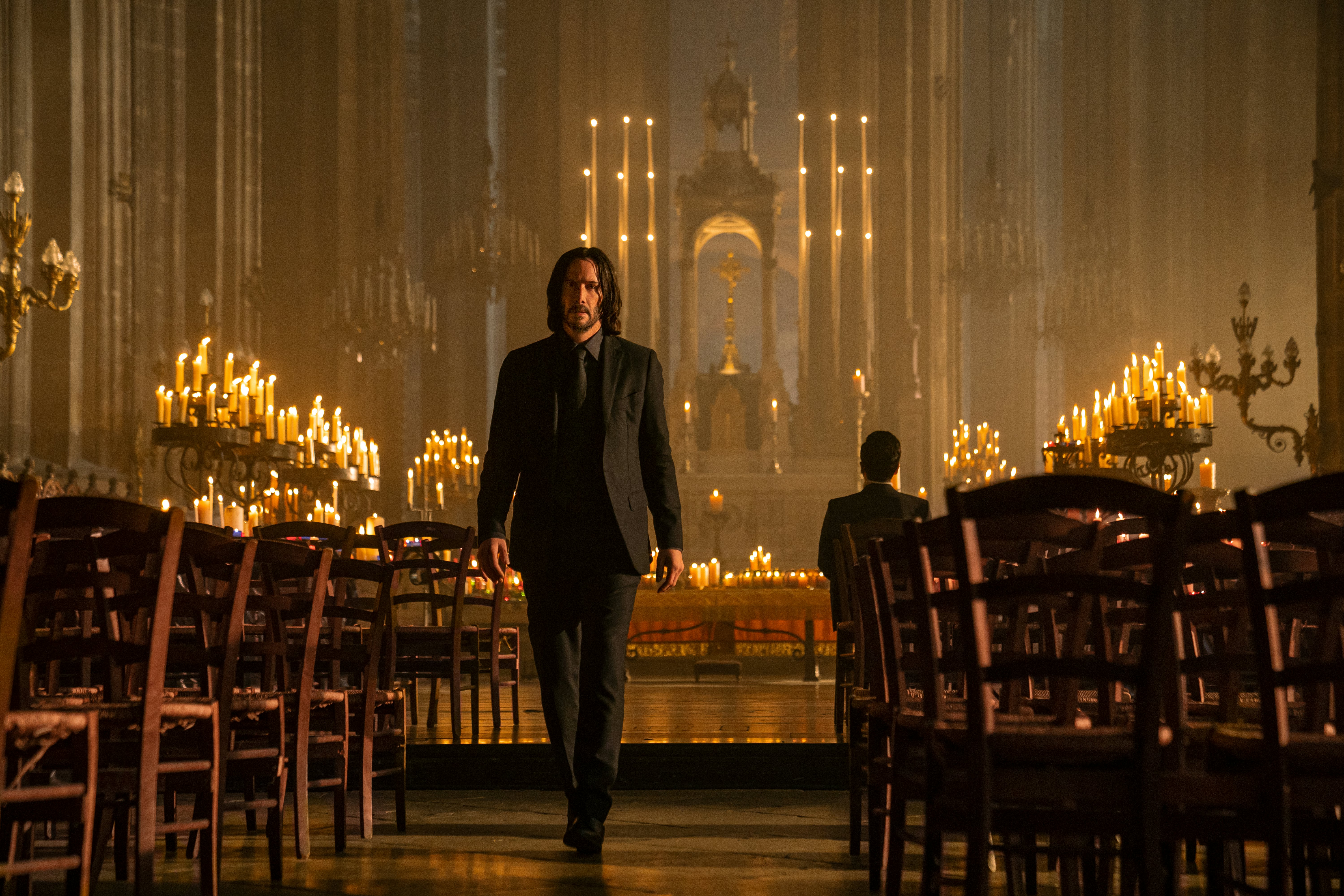
In the John Wick movies, there’s no such thing as overkill. This is a world where a headshot doesn’t guarantee a kill and loss of limb is just part of the job. It’s a world where Keanu Reeves can take a bullet to the chest, fall off a rooftop, and return stronger and more vengeful than ever. But in John Wick: Chapter 4 — director Chad Stahelski’s brutal ballet of jaw-dropping action filmmaking and jaw-breaking stunts — overkill takes on a whole new meaning.
Each John Wick movie already feels like a miracle of action filmmaking. The first injected a simple revenge thriller with the bloody beauty of a Hong Kong action movie, the second took the franchise to mythic new heights, and the third delivered all-star action crossovers. But the fourth manages to one-up all of them in the greatest display of action spectacle this side of Mad Max: Fury Road. John Wick: Chapter 4 is Stahelski’s magnum opus, a bone-crunching showcase of everything the director has honed and perfected over the course of the franchise, playing out over a massive three-hour runtime that absolutely breezes by.

John Wick: Chapter 4 picks up a few months after Chapter 3, with Wick healed from his injuries and ready to take on the High Table, the council of crime lords who rule over the assassin underworld. But the price on his head is only growing, and even the Baba Yaga can’t dispatch all the assassins on his tail — no matter how many times he growls that he will “kill them all.” With his allies, including the anarchic Bowery King (Laurence Fishburne, making a meal of his every scene) and the now-excommunicado Winston (Ian McShane, always imposing), also being targeted, John turns to one of his oldest friends: Osaka Continental Hotel manager Shimazu (Hiroyuki Sanada).
The two are soon crestfallen to learn that the High Table has turned their other old friend against them: Donnie Yen’s blind assassin Caine, another former hitman who left the life for love. Caine is being forced to kill John Wick at the orders of the High Table’s new frontman, the Marquis de Gramont (Bill Skarsgård), who is threatening the life of Caine’s daughter as an added incentive.

This is the first John Wick movie not written by franchise creator Derek Kolstad, with Shay Hatten (co-writer of Chapter 3) and Michael Finch penning the script instead. Kolstad’s absence can’t help but be felt in what is the most narratively simple franchise entry. The second and third films expanded the mythology to an almost awe-inspiring degree, introducing an underworld that felt heightened and lived-in all at once. But apart from a few fleeting remarks about the High Table and brief glimpses into the Marquis’ lavish lifestyle, the worldbuilding of John Wick: Chapter 4 feels mostly like a retread of the previous films. Even the narrative seems rehashed — John Wick is on the run again, he runs into secondary and tertiary antagonists who are dangerous thorns in his side again, and there’s a cute dog sidekick, again. But one of the key things that prevents John Wick: Chapter 4 from feeling like a pale shadow of the past films is the supporting cast, led by the inimitable Donnie Yen.
Yen’s Caine is a mirror image of John Wick and (to an extent) an even more sympathetic fire than the dog-loving Baba Yaga. Introduced in disguise watching his daughter play violin in a Paris courtyard, Yen brings the earnest melodrama of Hong Kong cinema that the John Wick films had been lacking (despite all their homages to the Hong Kong action movies of the ‘80s and ‘90s). Yen is that missing piece, providing the strongest emotional arc of the film through Caine’s turmoil over his fierce loyalty to his daughter, and his guilt over betraying his longtime friend. When Yen, Reeves, and Sanada are onscreen together, their unspoken history becomes tangible and helps shape the most personal arc for John Wick outside of the first film. It’s a testament to the trio’s charisma and chemistry that it’s so easy to buy into their offscreen history with two characters we’re just meeting now.

It also helps that Yen elevates every scene he’s in — almost to the point of stealing the movie right from under Reeves’ feet. Appearing exclusively in shades and a slick black suit, Yen has the effortless, laconic cool of Chow Yun Fat in every John Woo movie (and the best fight scenes of the film). Stahelski wisely dials back the gun-fu when it comes to Yen, letting him show off his natural prowess with Wing Chun that Yen is known for in scenes that breathlessly whip back and forth between hand-to-hand combat, sword fights, and good old-fashioned headshots.
It almost feels impossible for the rest of the cast to keep up, both emotionally and physically, but keep up they do: Sanada exudes a mournful gravitas in his handful of scenes, action movie mainstay Scott Adkins hams it up as what is essentially a kung-fu version of Colin Farrell’s Penguin, Rina Sawayama impresses in her first feature-film role, and Clancy Brown and Natalia Tena both add exciting color to the ensemble. Shamier Anderson is a refreshing addition as The Tracker, a mercenary bent on raising the price on John Wick’s head and the one guy who reacts normally to having his hand stabbed — though he does feel somewhat secondary as if the writers wanted to include at least one “dog guy” in the movie. Still, John Wick: Chapter 4 has the best supporting cast of a John Wick movie yet on the strength of Yen and the film’s main antagonist, the Marquis — Bill Skarsgård’s boyish looks and chilling, laser-focused grudge against John Wick making the Marquis out to feel like a hedonistic, tyrannical boy-king.

Perhaps that relatively simple narrative is what makes the cast shine. It certainly becomes a great boon for the action, which Stahelski takes to incredible new heights beyond anything that John Wick has ever done before. The signature long takes that allow the action to play out in one frame? Those are taken to the next level in an astonishing five-minute sequence where the camera soars to a bird’s-eye view as John fights his way through an apartment filled with assassins. It almost feels like a marriage between the steady Hong Kong action of the first film with a revitalized video game-inspired approach. Stahelski takes the spectacle to such lengths that the film starts to knowingly wink at the absurdity. Chapter 4 is also easily the funniest John Wick yet, with Reeves tapping into the character’s Buster Keaton roots in a recurring gag where John gets hit by at least seven cars throughout the film; or several scenes in which John shoots men multiple times in the head as they lay dead on the ground (just for good measure).
Given a relatively simple narrative and a script that was less beholden to the complex mythology of the franchise, it’s clear that Stahelski went into Chapter 4 no-holds-barred. The action, the spectacle, the humor, and the melodrama are all turned up to 11 in a film that is the most John Wick movie, for better or worse. Some might call it overkill, but with John Wick: Chapter 4, overkill is underrated.







